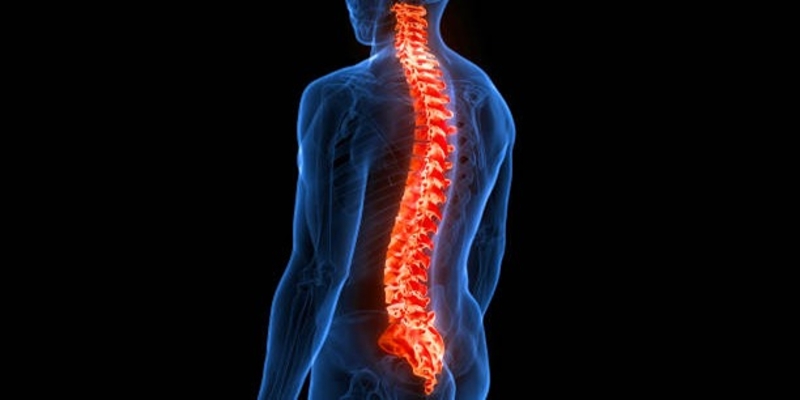Hanging Out for Health: Does a Dead Hang Really Elongate Your Spine
Feb 28, 2024 By Nancy Miller
The common pursuit of a healthier back and improved posture has many turning their gaze toward the underrated exercise known as the dead hang. This simple, yet effective maneuver involves suspending oneself from an overhead bar, using nothing but one's own grip. Enthusiasts claim that regularly performing dead hangs can not only strengthen the muscles of the upper body but also potentially elongate the spine, providing much-needed relief from the compressive forces of daily life. But how much truth lies within these claims? In this comprehensive examination, we'll delve into the anatomy and physiology behind dead hangs to explore their real effects on spinal health and determine whether they should be incorporated into your regular wellness routine.
The Anatomy of the Spine

Before diving into the benefits of dead hangs, it's important to understand the structure of the spine. The spine is made up of 33 vertebrae, including the cervical (neck), thoracic (mid-back), and lumbar (lower back) regions. These vertebrae are connected by intervertebral discs, small shock-absorbing cushions that allow for movement and flexibility. The spine also has natural curves, known as lordosis (inward curve) and kyphosis (outward curve), which help distribute weight and maintain balance.
What Causes Spinal Compression?
The spine is constantly subjected to gravitational forces and the weight of our bodies, leading to daily wear and tear. As we age, these forces can cause a gradual loss of intervertebral disc height, resulting in spinal compression. Poor posture, long periods of sitting, and lack of physical activity can exacerbate this process, leading to back pain and stiffness.
How the spine can be affected by physical activity?
Physical activity can have both positive and negative effects on the spine. Regular exercise, especially activities that involve weight-bearing or resistance training, can help strengthen the muscles that support the spine and improve overall spinal health. However, certain activities like heavy lifting or high-impact sports can put excessive strain on the spine, leading to injuries and potential damage.
The Benefits of Dead Hangs for Spinal Health
Now that we have a better understanding of the spine, let's explore how dead hangs can potentially benefit its health.
Strengthening the Muscles Supporting the Spine
Dead hangs primarily target the muscles of the upper body, including the shoulders, back, and core. These muscles play a crucial role in supporting and stabilizing the spine. Strengthening these muscles can help improve posture and reduce the risk of injury.
Decompressing the Spine
The weight of our bodies and daily activities can cause compression in the spine, leading to back pain and stiffness. Dead hangs involve suspending oneself from an overhead bar, allowing for a temporary decompression of the spine. This can provide relief and potentially increase intervertebral disc height.
Improving Grip Strength and Overall Fitness
Dead hangs require a strong grip, which can be beneficial for everyday activities like carrying groceries or lifting objects. Additionally, incorporating dead hangs into a regular exercise routine can improve overall fitness and contribute to a healthier lifestyle.
Promoting Good Posture
Poor posture can put strain on the spine and lead to pain and discomfort. Regularly performing dead hangs can help improve posture by strengthening back muscles and promoting proper alignment of the spine.
Low-Impact Exercise Option
Some physical activities can be too strenuous for the spine. Dead hangs offer a low-impact option for those looking to improve their physical fitness without putting excess strain on the spine.
How to Incorporate Dead Hangs into Your Routine?
If you're interested in adding dead hangs to your wellness routine, here are a few tips to keep in mind:
- Start with shorter durations and gradually increase the time as you build strength
- Use proper form, engaging the muscles of the upper back and avoiding excessive swinging or jerking movements
- Consider incorporating other exercises that target the core and upper body for a well-rounded workout
The Spine-Health Connection
It's important to note that while dead hangs may have potential benefits for spinal health, they should not be solely relied upon as a solution for back pain or other spinal issues. Maintaining overall spinal health requires a combination of proper posture, regular exercise, and healthy lifestyle habits.
Expert Opinions
While there hasn't been much scientific research specifically on the effects of dead hangs, experts agree that they can be a beneficial addition to one's exercise routine. Physical therapist Dr. Scott Weiss recommends incorporating dead hangs for back pain relief and overall spine health.
Alternatives for Spinal Health

While dead hangs can be a great option, they may not be suitable for everyone. Here are some alternative exercises that can also benefit spinal health:
- Planks: Engage the muscles of the core and back to improve posture and stability
- Swimming: The weightlessness in water can provide relief from compression on the spine while strengthening muscles
- Yoga: Various yoga poses can improve spinal flexibility and strength
- Walking: Low-impact exercise that can improve overall fitness and promote good posture
Conclusion
Dead hangs can be a helpful addition to one's wellness routine for spinal health. With proper form and gradually increasing duration, they can provide benefits such as strengthening muscles, decompressing the spine, improving grip strength and promoting good posture. However, it's important to also incorporate other exercises and maintain healthy lifestyle habits for overall spine health. Consult a healthcare professional if you have any concerns or pre-existing spinal conditions. So, whether you're hanging from a bar or engaging in other activities that support your spine, remember to prioritize its health as part of your regular wellness routine. Your back will thank you!

Combatting Dermatoporosis: The Latest Advances in Skincare Treatments

How Meditation Alters Your Perception of Time

Tretinoin vs. Retinol? What's The Difference Between The Two?

Top 3 Hyperextension Workouts For Your Back and Glute Muscles

Exploring Cupping Therapy: What It Is and How It Works

Best Practices for Storing Coconut Oil

Decoding Facial Care: How Often Is Ideal for Your Skin?


